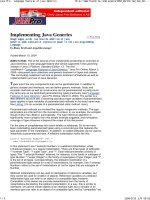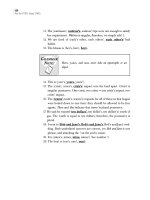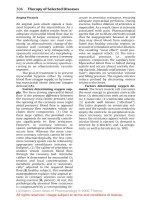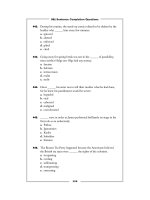Tài liệu Color Atlas of Pharmacology (Part 25): Therapy of Selected Diseases pptx
Bạn đang xem bản rút gọn của tài liệu. Xem và tải ngay bản đầy đủ của tài liệu tại đây (1.23 MB, 26 trang )
Angina Pectoris
An anginal pain attack signals a tran-
sient hypoxia of the myocardium. As a
rule, the oxygen deficit results from in-
adequate myocardial blood flow due to
narrowing of larger coronary arteries.
The underlying causes are: most com-
monly, an atherosclerotic change of the
vascular wall (coronary sclerosis with
exertional angina); very infrequently, a
spasmodic constriction of a morpholog-
ically healthy coronary artery (coronary
spasm with angina at rest; variant angi-
na); or more often, a coronary spasm oc-
curring in an atherosclerotic vascular
segment.
The goal of treatment is to prevent
myocardial hypoxia either by raising
blood flow (oxygen supply) or by lower-
ing myocardial blood demand (oxygen
demand) (A).
Factors determining oxygen sup-
ply. The force driving myocardial blood
flow is the pressure difference between
the coronary ostia (aortic pressure) and
the opening of the coronary sinus (right
atrial pressure). Blood flow is opposed
by coronary flow resistance, which in-
cludes three components. (1) Due to
their large caliber, the proximal coro-
nary segments do not normally contrib-
ute significantly to flow resistance.
However, in coronary sclerosis or
spasm, pathological obstruction of flow
occurs here. Whereas the more com-
mon coronary sclerosis cannot be over-
come pharmacologically, the less com-
mon coronary spasm can be relieved by
appropriate vasodilators (nitrates, ni-
fedipine). (2) The caliber of arteriolar re-
sistance vessels controls blood flow
through the coronary bed. Arteriolar
caliber is determined by myocardial O
2
tension and local concentrations of
metabolic products, and is “automati-
cally” adjusted to the required blood
flow (B, healthy subject). This metabolic
autoregulation explains why anginal at-
tacks in coronary sclerosis occur only
during exercise (B, patient). At rest, the
pathologically elevated flow resistance
is compensated by a corresponding de-
crease in arteriolar resistance, ensuring
adequate myocardial perfusion. During
exercise, further dilation of arterioles is
impossible. As a result, there is ischemia
associated with pain. Pharmacological
agents that act to dilate arterioles would
thus be inappropriate because at rest
they may divert blood from underper-
fused into healthy vascular regions on
account of redundant arteriolar dilation.
The resulting “steal effect” could pro-
voke an anginal attack. (3) The intra-
myocardial pressure, i.e., systolic
squeeze, compresses the capillary bed.
Myocardial blood flow is halted during
systole and occurs almost entirely dur-
ing diastole. Diastolic wall tension (“pre-
load”) depends on ventricular volume
and filling pressure. The organic nitrates
reduce preload by decreasing venous
return to the heart.
Factors determining oxygen de-
mand. The heart muscle cell consumes
the most energy to generate contractile
force. O
2
demand rises with an increase
in (1) heart rate, (2) contraction velocity,
(3) systolic wall tension (“afterload”).
The latter depends on ventricular vol-
ume and the systolic pressure needed to
empty the ventricle. As peripheral resis-
tance increases, aortic pressure rises,
hence the resistance against which ven-
tricular blood is ejected. O
2
demand is
lowered by β-blockers and Ca-antago-
nists, as well as by nitrates (p. 308).
306 Therapy of Selected Diseases
Lüllmann, Color Atlas of Pharmacology © 2000 Thieme
All rights reserved. Usage subject to terms and conditions of license.
Therapy of Selected Diseases 307
B. Pathogenesis of exertion angina in coronary sclerosis
O
2
-supply
during
diastole
O
2
-demand
during
systole
Flow resistance:
1. Coronary arterial
caliber
2. Arteriolar
caliber
3. Systolic wall
tension
= Afterload
1. Heart rate
2. Contraction
velocity
Peripheral
resistance
Venous
supply
Healthy subject Patient with coronary sclerosis
Rest
Exercise
A. O
2
supply and demand of the myocardium
Narrow Wide
Compensa-
tory
dilation of
arterioles
Rate
Contraction
velocity
Afterload
Wide Wide
Additional
dilation
not possible
Angina
pectoris
Left atrium
Coronary artery
Left ventricle
Pressure p
Vol.Vol.
Pressure p
Right
atrium
p-force
Time
Aorta
3. Diastolic
wall tension
= Preload
Venous
reservoir
Lüllmann, Color Atlas of Pharmacology © 2000 Thieme
All rights reserved. Usage subject to terms and conditions of license.
Antianginal Drugs
Antianginal agents derive from three
drug groups, the pharmacological prop-
erties of which have already been pre-
sented in more detail, viz., the organic
nitrates (p. 120), the Ca
2+
antagonists
(p. 122), and the β-blockers (pp. 92ff).
Organic nitrates (A) increase blood
flow, hence O
2
supply, because diastolic
wall tension (preload) declines as ve-
nous return to the heart is diminished.
Thus, the nitrates enable myocardial
flow resistance to be reduced even in
the presence of coronary sclerosis with
angina pectoris. In angina due to coro-
nary spasm, arterial dilation overcomes
the vasospasm and restores myocardial
perfusion to normal. O
2
demand falls
because of the ensuing decrease in the
two variables that determine systolic
wall tension (afterload): ventricular fill-
ing volume and aortic blood pressure.
Calcium antagonists (B) decrease
O
2
demand by lowering aortic pressure,
one of the components contributing to
afterload. The dihydropyridine nifedi-
pine is devoid of a cardiodepressant ef-
fect, but may give rise to reflex tachy-
cardia and an associated increase in O
2
demand. The catamphiphilic drugs ve-
rapamil and diltiazem are cardiode-
pressant. Reduced beat frequency and
contractility contribute to a reduction in
O
2
demand; however, AV-block and me-
chanical insufficiency can dangerously
jeopardize heart function. In coronary
spasm, calcium antagonists can induce
spasmolysis and improve blood flow
(p. 122).
β-Blockers (C) protect the heart
against the O
2
-wasting effect of sympa-
thetic drive by inhibiting β-receptor-
mediated increases in cardiac rate and
speed of contraction.
Uses of antianginal drugs (D). For
relief of the acute anginal attack, rap-
idly absorbed drugs devoid of cardiode-
pressant activity are preferred. The drug
of choice is nitroglycerin (NTG,
0.8–2.4 mg sublingually; onset of action
within 1 to 2 min; duration of effect
~30 min). Isosorbide dinitrate (ISDN)
can also be used (5–10 mg sublingual-
ly); compared with NTG, its action is
somewhat delayed in onset but of long-
er duration. Finally, nifedipine may be
useful in chronic stable, or in variant an-
gina (5–20 mg, capsule to be bitten and
the contents swallowed).
For sustained daytime angina pro-
phylaxis, nitrates are of limited value
because “nitrate pauses” of about 12 h
are appropriate if nitrate tolerance is to
be avoided. If attacks occur during the
day, ISDN, or its metabolite isosorbide
mononitrate, may be given in the morn-
ing and at noon (e.g., ISDN 40 mg in ex-
tended-release capsules). Because of
hepatic presystemic elimination, NTG is
not suitable for oral administration.
Continuous delivery via a transdermal
patch would also not seem advisable
because of the potential development of
tolerance. With molsidomine, there is
less risk of a nitrate tolerance; however,
due to its potential carcinogenicity, its
clinical use is restricted.
The choice between calcium antag-
onists must take into account the diffe-
rential effect of nifedipine versus verap-
amil or diltiazem on cardiac perfor-
mance (see above). When β-blockers are
given, the potential consequences of re-
ducing cardiac contractility (withdraw-
al of sympathetic drive) must be kept in
mind. Since vasodilating β
2
-receptors
are blocked, an increased risk of va-
sospasm cannot be ruled out. Therefore,
monotherapy with β-blockers is recom-
mended only in angina due to coronary
sclerosis, but not in variant angina.
308 Therapy of Selected Diseases
Lüllmann, Color Atlas of Pharmacology © 2000 Thieme
All rights reserved. Usage subject to terms and conditions of license.
Therapy of Selected Diseases 309
D. Clinical uses of antianginal drugs
B. Effects of Ca-antagonists
O
2
-supply O
2
-demand
Afterload
Rate
Contraction
velocity
A. Effects of nitrates
C. Effects of
β
-blockers
Exercise
Rest
Sympathetic
system
β-blocker
Relaxation
of
resistance
vessels
Relaxation of
coronary spasm
Ca-
antagonists
Afterload
O
2
-demand
p
Preload
Nitrates e.g., Nitroglycerin (GTN), Isosorbide dinitrate (ISDN)
Nitrate
tolerance
Relaxation of
coronary spasm
Venous
capacitance
vessels
Resistance
vessels
Vasorelaxation
Angina pectoris
Coronary sclerosis Coronary spasm
GTN, ISDN
Nifedipine
Long-acting nitrates
Ca-antagonistsβ-blocker
Therapy of attack
Anginal prophylaxis
p Diastole pSystole
Vol Vol
Lüllmann, Color Atlas of Pharmacology © 2000 Thieme
All rights reserved. Usage subject to terms and conditions of license.
Acute Myocardial Infarction
Myocardial infarction is caused by
acute thrombotic occlusion of a coronary
artery (A). Therapeutic interventions
aim to restore blood flow in the occlud-
ed vessel in order to reduce infarct size
or to rescue ischemic myocardial tissue.
In the area perfused by the affected ves-
sel, inadequate supply of oxygen and
glucose impairs the function of heart
muscle: contractile force declines. In the
great majority of cases, the left ventricle
(anterior or posterior wall) is involved.
The decreased work capacity of the in-
farcted myocardium leads to a reduc-
tion in stroke volume (SV) and hence
cardiac output (CO). The fall in blood
pressure (RR) triggers reflex activation
of the sympathetic system. The resul-
tant stimulation of cardiac β-adreno-
ceptors elicits an increase in both heart
rate and force of systolic contraction,
which, in conjunction with an α-adren-
oceptor-mediated increase in peripher-
al resistance, leads to a compensatory
rise in blood pressure. In ATP-depleted
cells in the infarct border zone, resting
membrane potential declines with a
concomitant increase in excitability
that may be further exacerbated by acti-
vation of β-adrenoceptors. Together,
both processes promote the risk of fatal
ventricular arrhythmias. As a conse-
quence of local ischemia, extracellular
concentrations of H
+
and K
+
rise in the
affected region, leading to excitation of
nociceptive nerve fibers. The resultant
sensation of pain, typically experienced
by the patient as annihilating, reinforces
sympathetic activation.
The success of infarct therapy criti-
cally depends on the length of time
between the onset of the attack and the
start of treatment. Whereas some thera-
peutic measures are indicated only after
the diagnosis is confirmed, others ne-
cessitate prior exclusion of contraindi-
cations or can be instituted only in spe-
cially equipped facilities. Without ex-
ception, however, prompt action is im-
perative. Thus, a staggered treatment
schedule has proven useful.
The antiplatelet agent, ASA, is ad-
ministered at the first suspected signs of
infarction. Pain due to ischemia is treat-
ed predominantly with antianginal
drugs (e.g., nitrates). In case this treat-
ment fails (no effect within 30 min, ad-
ministration of morphine, if needed in
combination with an antiemetic to pre-
vent morphine-induced vomiting, is in-
dicated. If ECG signs of myocardial in-
farction are absent, the patient is stabi-
lized by antianginal therapy (nitrates, β-
blockers) and given ASA and heparin.
When the diagnosis has been con-
firmed by electrocardiography, at-
tempts are started to dissolve the
thrombus pharmacologically (thrombo-
lytic therapy: alteplase or streptoki-
nase) or to remove the obstruction by
mechanical means (balloon dilation or
angioplasty). Heparin is given to pre-
vent a possible vascular reocclusion, i.e.,
to safeguard the patency of the affected
vessel. Regardless of the outcome of
thrombolytic therapy or balloon dila-
tion, a β-blocker is administered to sup-
press imminent arrhythmias, unless it is
contraindicated. Treatment of life-
threatening ventricular arrhythmias
calls for an antiarrhythmic of the class
of Na
+
-channel blockers, e.g., lidocaine.
To improve long-term prognosis, use is
made of a β-blocker (ȇ incidence of re-
infarction and acute cardiac mortality)
and an ACE inhibitor (prevention of
ventricular enlargement after myocar-
dial infarction) (A).
310 Therapy of Selected Diseases
Lüllmann, Color Atlas of Pharmacology © 2000 Thieme
All rights reserved. Usage subject to terms and conditions of license.
Therapy of Selected Diseases 311
no
A. Drugs for the treatment of acute myocardial infarction
A. Algorithm for the treatment of acute myocardial infarction
no
yes
yes
Suspected myocardial
infarct
Acetylsalicylic
acid
Ischemic pain
ECG
Thrombolysis
contraindicated
yes
Angioplasty
contraindicated
Glycerol trinitrate
Force
SV
RR
SV x HR = CO
SV x HR = CO
H
+
K
+
Pain
Preload reduction:
nitrate
Afterload reduction:
ACE-inhibitor
Antiplatelet
drugs,
thrombolytic
agent,
heparin
If needed:
antiarrhythmic:
e.g., lidocaine
Persistent pain:
opioids and if
needed: antiemetics
β-blocker
Analgesic:
opioids
Infarct
α
ββ β
Excitability
Arrhythmia
Sympathetic
nervous system
Peripheral
resistance
no
Standard therapy
β-blocker, ACE-inhibitor, optional heparin
ST-segment
elevation
left bundle block
Thrombolysis
successful
no
Angioplasty
opt. GPIIb/IIIA-
blocker
yes
yes
no
Lüllmann, Color Atlas of Pharmacology © 2000 Thieme
All rights reserved. Usage subject to terms and conditions of license.
Hypertension
Arterial hypertension (high blood pres-
sure) generally does not impair the
well-being of the affected individual;
however, in the long term it leads to
vascular damage and secondary compli-
cations (A). The aim of antihypertensive
therapy is to prevent the latter and,
thus, to prolong life expectancy.
Hypertension infrequently results
from another disease, such as a cate-
cholamine-secreting tumor (pheochro-
mocytoma); in most cases the cause
cannot be determined: essential (pri-
mary) hypertension. Antihypertensive
drugs are indicated when blood pres-
sure cannot be sufficiently controlled by
means of weight reduction or a low-
salt diet. In principle, lowering of either
cardiac output or peripheral resistance
may decrease blood pressure (cf. p. 306,
314, blood pressure determinants). The
available drugs influence one or both of
these determinants. The therapeutic
utility of antihypertensives is deter-
mined by their efficacy and tolerability.
The choice of a specific drug is deter-
mined on the basis of a benefit:risk as-
sessment of the relevant drugs, in keep-
ing with the patient’s individual needs.
In instituting single-drug therapy
(monotherapy), the following consider-
ations apply: β-blockers (p. 92) are of
value in the treatment of juvenile hy-
pertension with tachycardia and high
cardiac output; however, in patients
disposed to bronchospasm, even β
1
-se-
lective blockers are contraindicated.
Thiazide diuretics (p. 162) are potential-
ly well suited in hypertension associat-
ed with congestive heart failure; how-
ever, they would be unsuitable in hypo-
kalemic states. When hypertension is
accompanied by angina pectoris, the
preferred choice would be a β-blocker
or calcium antagonist (p. 122) rather
than a diuretic. As for the calcium an-
tagonists, it should be noted that verap-
amil, unlike nifedipine, possesses car-
diodepressant activity. α-Blockers may
be of particular benefit in patients with
benign prostatic hyperplasia and im-
paired micturition. At present, only β-
blockers and diuretics have undergone
large-scale clinical trials, which have
shown that reduction in blood pressure
is associated with decreased morbidity
and mortality due to stroke and conges-
tive heart failure.
In multidrug therapy, it is neces-
sary to consider which agents rationally
complement each other. A β-blocker
(bradycardia, cardiodepression due to
sympathetic blockade) can be effective-
ly combined with nifedipine (reflex
tachycardia), but obviously not with ve-
rapamil (bradycardia, cardiodepres-
sion). Monotherapy with ACE inhibitors
(p. 124) produces an adequate reduc-
tion of blood pressure in 50% of pa-
tients; the response rate is increased to
90% by combination with a (thiazide)
diuretic. When vasodilators such as di-
hydralazine or minoxidil (p. 118) are
given, β-blockers would serve to pre-
vent reflex tachycardia, and diuretics to
counteract fluid retention.
Abrupt termination of continuous
treatment can be followed by rebound
hypertension (particularly with short
t
1/2
β-blockers).
Drugs for the control of hyperten-
sive crises include nifedipine (capsule,
to be chewed and swallowed), nitrogly-
cerin (sublingually), clonidine (p.o. or
i.v., p. 96), dihydralazine (i.v.), diazoxide
(i.v.), fenoldopam (by infusion, p. 114)
and sodium nitroprusside (p. 120, by in-
fusion). The nonselective α-blocker
phentolamine (p. 90) is indicated only
in pheochromocytoma.
Antihypertensives for hyperten-
sion in pregnancy are β
1
-selective
adrenoceptor-blockers, methyldopa
(p. 96), and dihydralazine (i.v. infusion)
for eclampsia (massive rise in blood
pressure with CNS symptoms).
312 Therapy of Selected Diseases
Lüllmann, Color Atlas of Pharmacology © 2000 Thieme
All rights reserved. Usage subject to terms and conditions of license.
Therapy of Selected Diseases 313
In severe cases further combination with
A. Arterial hypertension and pharmacotherapeutic approaches
Diur
etics
β
-blockers
Ca-
antagonists
α
1
-blockers
ACE inhibitors
A
T
1
-antagonists
If therapeutic
result inadequate
change to drug
from another group
or
combine with
drug from another group
Drug selection
according to conditions
and needs of the
individual patient
Initial monotherapy
with one of the five
drug groups
Antihypertensive therapy
Hypertension
Systolic: blood pressure > 160 mmHg
Diastolic: blood pressure > 96 mmHg
Secondary diseases:
Heart failure
Coronary atherosclerosis
angina pectoris, myocardial
infarction, arrhythmia
Atherosclerosis of cerebral vessels
cerebral infarction stroke
Cerebral hemorrhage
Atherosclerosis of renal vessels
renal failure
Decreased life expectancy
[mm Hg]
α-blocker
e.g.,
prazosine
Central
α
2
-agonist
e.g., clonidine
Vasodilation
e.g.,
dihydralazine
minoxidil
Reserpine
Lüllmann, Color Atlas of Pharmacology © 2000 Thieme
All rights reserved. Usage subject to terms and conditions of license.
Hypotension
The venous side of the circulation, ex-
cluding the pulmonary circulation, ac-
commodates ~ 60% of the total blood
volume; because of the low venous
pressure (mean ~ 15 mmHg) it is part of
the low-pressure system. The arterial
vascular beds, representing the high-
pressure system (mean pressure,
~ 100 mmHg), contain ~ 15%. The arteri-
al pressure generates the driving force
for perfusion of tissues and organs.
Blood draining from the latter collects in
the low-pressure system and is pumped
back by the heart into the high-pressure
system.
The arterial blood pressure (ABP)
depends on: (1) the volume of blood per
unit of time that is forced by the heart
into the high-pressure system—cardiac
output corresponding to the product of
stroke volume and heart rate (beats/
min), stroke volume being determined
inter alia by venous filling pressure; (2)
the counterforce opposing the flow of
blood, i.e., peripheral resistance, which
is a function of arteriolar caliber.
Chronic hypotension (systolic BP
< 105 mmHg). Primary idiopathic hypo-
tension generally has no clinical impor-
tance. If symptoms such as lassitude
and dizziness occur, a program of physi-
cal exercise instead of drugs is advis-
able.
Secondary hypotension is a sign of
an underlying disease that should be
treated first. If stroke volume is too low,
as in heart failure, a cardiac glycoside
can be given to increase myocardial
contractility and stroke volume. When
stroke volume is decreased due to insuf-
ficient blood volume, plasma substi-
tutes will be helpful in treating blood
loss, whereas aldosterone deficiency re-
quires administration of a mineralocor-
ticoid (e.g., fludrocortisone). The latter
is the drug of choice for orthostatic hy-
potension due to autonomic failure. A
parasympatholytic (or electrical pace-
maker) can restore cardiac rate in
bradycardia.
Acute hypotension. Failure of or-
thostatic regulation. A change from the
recumbent to the erect position (ortho-
stasis) will cause blood within the low-
pressure system to sink towards the feet
because the veins in body parts below
the heart will be distended, despite a re-
flex venoconstriction, by the weight of
the column of blood in the blood ves-
sels. The fall in stroke volume is partly
compensated by a rise in heart rate. The
remaining reduction of cardiac output
can be countered by elevating the pe-
ripheral resistance, enabling blood pres-
sure and organ perfusion to be main-
tained. An orthostatic malfunction is
present when counter-regulation fails
and cerebral blood flow falls, with resul-
tant symptoms, such as dizziness,
“black-out,” or even loss of conscious-
ness. In the sympathotonic form, sympa-
thetically mediated circulatory reflexes
are intensified (more pronounced
tachycardia and rise in peripheral resis-
tance, i.e., diastolic pressure); however,
there is failure to compensate for the re-
duction in venous return. Prophylactic
treatment with sympathomimetics
therefore would hold little promise. In-
stead, cardiovascular fitness training
would appear more important. An in-
crease in venous return may be
achieved in two ways. Increasing NaCl
intake augments salt and fluid reserves
and, hence, blood volume (contraindi-
cations: hypertension, heart failure).
Constriction of venous capacitance ves-
sels might be produced by dihydroer-
gotamine. Whether this effect could al-
so be achieved by an α-sympathomi-
metic remains debatable. In the very
rare asympathotonic form, use of sympa-
thomimetics would certainly be reason-
able.
In patients with hypotension due to
high thoracic spinal cord transections
(resulting in an essentially complete
sympathetic denervation), loss of sym-
pathetic vasomotor control can be com-
pensated by administration of sympa-
thomimetics.
314 Therapy of Selected Diseases
Lüllmann, Color Atlas of Pharmacology © 2000 Thieme
All rights reserved. Usage subject to terms and conditions of license.
Therapy of Selected Diseases 315
A. Treatment of hypotension
Heart
Kidney
Intestines
Skeletal muscle
Lung
Brain
Low-pressure
system
High-pressure
system
Venous
return
Stroke vol. x rate
= cardiac output
Blood pressure (BP)
Peripheral resistance
α-Sympatho-
mimetics
Arteriolar
caliber
β-Sympathomimetics
Cardiac
glycosides
Parasym-
patholytics
Redistribution of blood volume
Initial condition
Constriction of venous capacitance
vessels, e.g., dihydroergotamine if
appropriate, α-sympathomimetics
Increase of blood volume
BP
Sa
lt
NaCl + H
2
O
0,9%
NaCl
NaCl
+ H
2
O
Mineralo-
corticoid
BP
BP
Lüllmann, Color Atlas of Pharmacology © 2000 Thieme
All rights reserved. Usage subject to terms and conditions of license.









